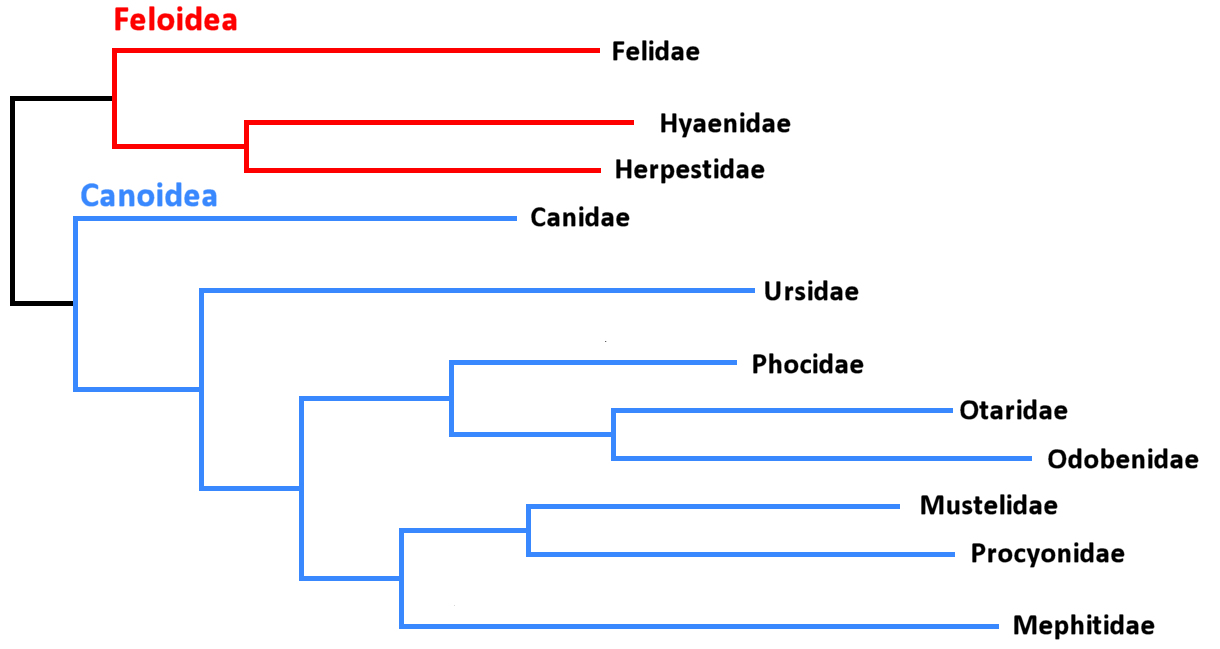
Relationship of Phylogeny to "Natural Classification"
& Principles of Nomenclature

A taxon (plural, taxa) is a group of organisms
that is assigned a particular name at some categorical rank. The categories
used in zoological taxonomy are Kingdom,
Phylum, Class, Order,
Family, Genus, & Species, ranked in order from
most to least inclusive. [A time-honored mnemonic for KPCOFGS
is 'King Philip Came Over For Good Sex']. Any of the
categories may be modified by the prefixes Super- or Sub-,
which indicate more or less inclusive groups, respectively.
Familial names often include a suffix that indicates rank within
Orders: these are -oidea for a superfamily, -idae
for a family, and -inae for a subfamily.
Other category names sometimes used include Tribe (between
Family and Genus), for which the suffix is -ini.
Taxon-specific naming conventions includes the suffix -a
for Mammalian orders, -iformes for Bird families, and
substitution of Division for Phylum in botanical
taxonomy.
Assignment of
names for newly-discovered taxa, and resolution of conflicting
names, is done according to quasi-legal, formal rules in nomenclature, the science of
naming. For example, the genus names of Harp Seals and Ivory
Gulls are Pagophilus and Pagophila,
respectively, -us being a Latin masculine ending and -a
a feminine ending. Under the rules, taxon names differing in
gender are permitted. The rules of nomenclature further require
that species names agree with the genus names in Latin gender:
seals are Pagophilus groenlandicus and
gulls Pagophila eburnea. For the seals,
this is true even though they were originally given the
masculine name of Phoca groenlandica: the grammatical
rule takes precedence over the stability rule.
The network shows
the phylogenetic relationships (evolutionary history) of
eleven taxonomic families in the Class Mammalia.
The animals shown are part of a single evolutionary lineage that
has been assigned the taxon name
Carnivora at the category rank of Order.
Within this order, various groups of animals have evolved,
including the cat-like superfamily Feloidea,
including large & small cats in the family Felidae, and the superfamily Canoidea, including bear-, dog-,
& weasel-like, in the families Ursidae,
Canidae, & Mustelidae,
respectively. The categorical rank of each of these groups as a
family is indicated by the -idae
suffix.
Within Mustelidae, two lineages corresponding to
weasels and martens are recognized among others, which have
been assigned the genus names Mustela
and Martes,
respectively: names in capitalized italics indicate the genus category (plural, genera). Particular forms of weasels
and martens are the species (sing.,
species) Mustela erminea
and Martes americana. With no exceptions, the
invariant rule is that genus & species names are always
written in italics, genus names
are always capitalized, and
species names are always in lower-case.
After the first use in scientific writing, and (or) where
it will not be ambiguous, the genus name may be abbreviated, in
this case as M. erminea and M. americana.
Other taxonomic arrangements are possible. Dog- & cat-like carnivores may be placed either in separate superfamilies as above. Taxonomists who wish to emphasize differences or degree of relationship may place them in different suborders: Caniformia and Feliformia. [Note the suffix -iformia, similar to that used for bird orders, except ending in -a].
Modern
classification is based on Linnaeus's Systema Naturae
(1758), which is described as hierarchical, because each
level of category names is contained entirely within the next
more inclusive category. The system is natural because
the hierarchy of categorical names unambiguously
indicates the degree of evolutionary relationship among
organisms. For example, organisms placed in the same
genus are understood to be more closely related to each other
than those in different genera in the same family, and organisms
in the same family are more closely related than those in
different orders. Ranking within more inclusive taxa reflects
degree of common ancestry. A natural classification allows
instant recognition of the current hypothesis of evolutionary
relationships among organisms.
An important feature of phylogenetic taxonomy is that the classification of creatures in any category is a hypothesis as to how its component taxa are related. New data or analysis may revise that hypothesis. For example, Linnaeus (1758) placed all true (eared) seals of the North Atlantic in the single genus Phoca. Subsequent molecular investigation divides these into several genera, in particular separating Harp Seals (Pagophilus) as only distantly related to Harbor Seals (Phoca).